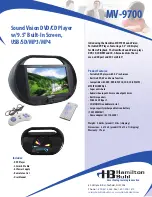
8
OPM-141/E
EXHAUST INSTALLATION
WARNING: PERSONAL INJURY
Improper exhaust installation will allow dangerous gases
to seep into enclosed spaces causing a hazard to your
health and/or death.
All exhaust must be piped out of the enclosure. When
selecting a location to exhaust fumes make sure that the
potential for contact with people is controlled. Exhaust can
enter buildings through windows, ventilation systems and
other openings if proper precautions are not followed.
The exhaust must be isolated from the vibration of the
engine. If the exhaust is connected in a rigid system it will
result in damage to the engine. The generator comes
equipped with an engine mounted flex pipe to aid your
installation. Ensure proper alignment with the generator.
The flex can be eliminated if it is pushed to one side to make
a connection.
The most direct path possible should be used to get to the
outside of the enclosure. Each bend restricts the pipe and
increases back pressure. It may be necessary to increase the
exhaust pipe diameter in some applications.
The exhaust pipe is very hot. When passing through the
structure it is critical that a thimble or other appropriate
technique is used to dissipate the heat and prevent the
structure from catching on fire.
Water in the exhaust pipe and especially the Diesel
Oxidation Catalyst (DOC) will cause damage to the engine.
It is preferable to exhaust out the side of the enclosures.
Slope the pipe slightly downward away from the engine
to cause any water in the exhaust to run away from the
engine. Do not exhaust near intake. Once outside the
enclosure a rain cap or other technique must be used to
keep water out of the exhaust. In mobile applications make
sure the rain flap faces to the rear of the vehicle so that it is
not blown open during transportation.
In many applications the DOC works as the muffler. If it is
desired to decrease engine noise further adding a muffler to
the exhaust system is possible. The muffler cannot increase
back pressure to more than 0.725 psi.
FUEL INSTALLATION
The fuel supply should be as close to the engine as
possible. This will reduce the installation cost of fuel runs
and minimize line losses. The diesel fuel supply should be
no more than 3 feet below the fuel inlet pump. If your
fuel supply is lower than 3 feet, you may have to install an
additional lift pump to bring the fuel up to the mechanical
fuel pump on the engine.
The information in this manual is offered to assist you in
providing the proper fuel for your engine. However, this
information is only provided to inform you of the engine’s
requirements and assist in making you aware of the
decisions you must make. In no case should the instructions
or information provided be interpreted to conflict with any
local, state, or national codes. If in doubt, always consult
your local fire marshal or fuel supplier.
INSTALLING THE FUEL LINE
Engine-generator sets are properly adjusted before they
leave the factory. Connecting a fuel supply with adequate
supply volume is critical to reliable operation. Diesel units
with optional base mounted fuel tanks are pre-plumbed to
the mechanical fuel pump on the engine.
Open skid mounted diesel units are often supplied with
capped inlet and return lines. The use of a suitable customer
supplied flexible fuel lines is essential between the engine
and fuel supply to provide a vibration break between your
fuel supply and the engine.
WARNING: FIRE DANGER:
Connecting rigid fuel line (i.e. steel or copper line) directly
to the inlet fuel filter or fuel pump may cause the fuel line
to crack during operation creating a serious fire hazard.
ELECTRICAL CONNECTIONS
NOTICE: CLASS 1 WIRING METHODS ARE TO BE USED FOR
ALL FIELD WIRING CONNECTIONS TO TERMINALS OF A
CLASS 2 CIRCUIT
NOTE: The symbol always indicates ground where
shown. All wiring must be completed in accordance with
the National Electric Code as well as any state and local
codes.
You must pay particular attention to wire size requirement
for the amperage of service you are dealing with. The table
below provides you guidance on wire sizing based on
both wire type and amperage. Wire amperages have been
derated for 40° C ambient temperatures operation.
GENERATOR CIRCUIT BREAKER
This unit DOES NOT come with a circuit breaker. The circuit
breaker will provide overload protection for the generator.
The following table gives you the recommended circuit
breaker size specifications. See actual breaker for wire
capabilities and torque specifications and restrictions.
Watts
Voltage
Phase
CB AMP
40,000
120/240
1
175-200
40,000
120/208
3
150-175
40,000
120/240
3
125-50
40,000
277/480
3
60-75
Fuel Inlet
Connection
Fuel Return
Line Connection
Содержание DE4040F4
Страница 31: ...31 OPM 141 E ENGINE HARNESS ...









































